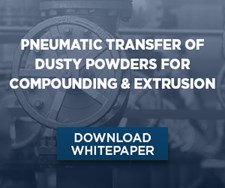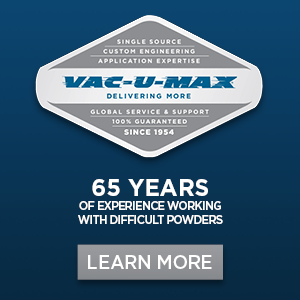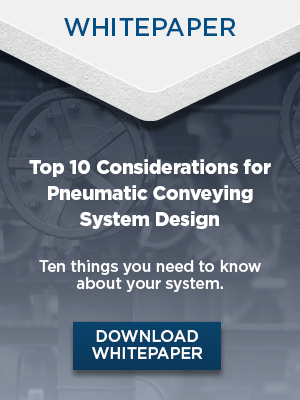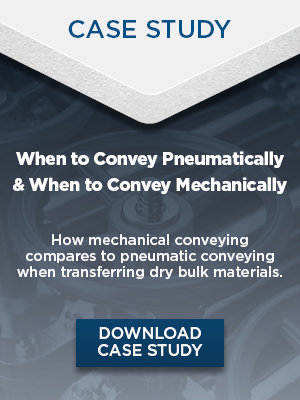Seven Key Factors to Consider When Vacuum Conveying Powders
Sponsored ContentPneumatic conveying is an efficient way to move plastic materials, but not all systems are created equal. Discover how powders pose their own set of challenges and how to handle them.
Share
Every powder conveying application is unique. But unlike plastic pellets, moving powders can be especially demanding for plastics processors. With powders, it’s critical to consider factors such as conveying rates and distances, material characteristics, flow aids, pick-up and discharge, filtration and safety concerns that can impact the entire operation.
No one understands this better than VAC-U-MAX, provider of material handling systems and components with experience handling over 10,000 different powders and resins. An industry expert in pneumatic conveying, VAC-U-MAX builds material handling systems specifically designed for continuous vacuum conveying powders to gravimetric blenders and other process equipment for applications including extrusion, compounding and resin pellet production.
Compared to mechanical conveying, vacuum conveying easily accommodates elevation and directional changes in between the source and the destination and is the preferred technology for transporting combustible powders such as resins and polymers. Whether for powders, flakes or fibers, it also improves the accuracy of the process and increases throughput by eliminating the inconsistencies of manual refilling.
Prior to building a system, VAC-U-MAX tests customers’ materials for flow characteristics and other qualities under simulated conditions at its fully equipped testing laboratory. Here are a few vital components to vacuum conveying powdered resins and what to consider:
1. Material
It is crucial to understand how a particular powder will behave under certain conditions when configuring a vacuum conveying system. In the plastics industry, a customer might specify whether their material is free-flowing, sluggish or non-free flowing, which can impact conveying needs. One product might consist of several grades, with each behaving differently than the other. Combustible powders present serious safety risks and materials may also behave differently depending on environmental elements such as elevation, temperature or humidity.

Material Considerations
- flow properties
- bulk density
- particle size and shape
- particle attrition and distribution
- chemical compatibility
- product degradation
- combustible properties
Powder Descriptions
- fine
- cohesive
- floodable
- free-flowing
- non-free-flowing
- sluggish
- abrasive
Whether you’re working with titanium dioxide, iron oxide, zinc oxide or calcium carbonate, each type of compound presents its own set of challenges. By understanding your materials, you can focus on reducing material degradation and power consumption, maximizing system efficiency and ultimately improving end-product quality.
Not quite sure? Plastics processors might be misinformed or unfamiliar with properties of their materials, which can put the entire operation at risk for quality issues and potential downtime. Testing your material in advance can reveal exactly what your conveying system needs to be efficient and safe.
2. Pickup Point
Pickup points sometimes require the most customization and attention in the system. The pickup point can be configured with a wand for a simple “up-and-in” system, bag dump station, bulk bag unloader, and in some cases, silo or railcar, all dependent on the container holding the material at the beginning of the process.
The pickup point also poses a challenge for powder when it comes to efficient material transfer. There must be a means to aerate the powder so that it flows freely into the tubing from start to finish. As a result, the pickup point is vital in ensuring quality at the start of the process.
3. Discharge
Powders do not flow like pellets. And not all powders are the same. Some powders are cohesive but others tend to “bridge”, “rat-hole” or clump when discharged, impeding material flow from the hopper to the material receiver. As a result, it is critical that the discharge configuration match the material.
Non-free-flowing powders often require the most equipment modifications, and there are a variety of discharge methods to handle these powders, such as over-sized receiver discharge openings as well as 70° and other cone-less, “jam-proof” vacuum receivers.
For difficult-to-move powders, the key is to move the material at a constant rate from the pickup point to the material line and at a constant rate from the discharge point to the material receiver.
4. System Control
If the vacuum pump is the heart of the system, the control panel is the brains. Even the simplest systems utilize a micro PLC to control convey, refill, discharge and pulse functions, and more complex PLC control panels are equipped for batch weigh systems and multi-ingredient handling systems. These systems weigh material at the pick-up point for a loss-in-weight transfer or at the discharge end of the system for a gain-in-weight transfer.
Vacuum conveying systems and related controls are ideal for feeder refill, particularly in applications where pigments, additives, flakes, fibers and other materials are added to gravimetric blenders or the continuous feeder refills upstream to the extruder.

The Signature Series™ receivers from VAC-U-MAX offers a variety of models that cater to different types of powders and bulk materials, conveying rates and distances and other design factors. The 3500 Series displayed here is designed to convey up to 3,500 lbs./hr.
The Signature Series™ vacuum receivers from VAC-U-MAX, for example, fill to a pre-defined level and hold the material charge until the loss-in-weight feeder requests refill. When a loss-in-weight feeder reaches a low-level signal, the discharge valve on the vacuum receiver opens, refilling the feeder in seconds, enabling it to operate in gravimetric mode as soon as possible by having a charge of material ready in the vacuum receiver at all times.
5. Dust Filtration
Today’s manufacturing environment focuses a great deal on plant sanitation, safety, and process efficiency. Systems handle particles measured in microns, some even less than 10 microns and invisible to the human eye that can remain suspended in the air for days. As a result, properly designed air and dust filtration systems are extremely important to the success and safety of any bulk powder handling system. The type of powder and its characteristics will largely dictate the filtration system needed.
With some systems conveying over 5,000 lb./hr. of extremely dusty powders, proper filter maintenance is essential for peak system performance. For especially difficult powders, suitable filters and filter replacement can make a major difference. Filters separate the product from the clean air traveling back to the vacuum producer. With ultra-fine powders, filters can clog the conveying process.
VAC-U-MAX uses conductive filters and intuitive pulse filter cleaning systems to keep all filters running efficiently. Other filtering factors to consider include the material of the filter, number of filters, size of the filter area, filter placement and the cleaning cycle.
6. Cleaning
Cleaning the conveying line of residual material is vital to process efficiency and quality control for applications requiring change-over. For processors using multiple materials, it’s important to quickly and easily clean out the line, pickup, drop off and other components that can interfere with the next batch. When changing materials or recipes, there’s a major risk of contamination. As a result, it’s important to look for features of quick color-change and easy cleanout.
Even cohesive and lightweight powders are prone to sticking and can cause “bridging” and “rat-holing,” so it’s important, especially where change-over is concerned, to consider not only your operation as a whole but the materials themselves for a clean operation.
7. Safety
The number one advantage of vacuum conveying for powders is dust control, especially in the plastics industry, where combustible dust is a serious safety issue. Vacuum conveying is a “closed process” in which powders are protected from ambient air in the plant. As a result, it is the preferred technology for transporting combustible powders. Some materials present a risk for combustible dust explosion or harmful environmental impact, so the system needs to ensure that the material is contained.
As vacuum conveying automated the material handling process, material can now be conveyed from source to destination, without the need for manual dumping of the powders into the process. This eliminates stair climbing and fugitive dust, improving employee safety.
With OSHA and NFPA to name a couple, there are several strict regulations that require a well-designed system. Testing material beforehand will provide insight into these properties, how to meet all necessary regulations, and how to promote plant safety.
Pneumatic conveying has proven itself as an efficient way to handle several types of powder materials and has made advancements in automating the entire process, while accommodating even the most challenging materials. Properly designed bulk material transfer systems contribute to the continued success of the system, while reducing maintenance, equipment downtime and power consumption.
Not all powders require complicated, custom-made equipment; materials can be accommodated using standard “plug-and-play” components with several cost-effective options available. Having even a basic understanding of material properties and operation needs is the first step to solving costly conveying problems and cutting costs associated with inefficient systems.
That’s why VAC-U-MAX takes the scientific approach. Their fully-equipped, 3,000-square-foot test lab can setup or replicate virtually any system with a variety of equipment configurations. VAC-U-MAX systems incorporate required conveying rates, system design and functionality, pick-up point design, selection of material flow aid devices, and interface recommendations for process equipment both upstream and downstream.
Whether designed for compounding, extrusion or resin production, customers can submit a sample and identify exact application needs.
Learn more about VAC-U-MAX.




